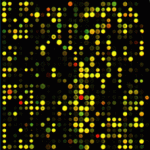Genomics
|
11 may 2012 17:04:50 |
| The dependence of expression of NF-kappaB-dependent genes: statistics and evolutionary conservation of control sequences in the promoter and in the 3` UTR (BMC Genomics) |
|
Tweet Background:
The NF-kappaB family plays a prominent role in the innate immune response, cell cycle activation or cell apoptosis. Upon stimulation by pathogen-associated patterns, such as viral RNA a kinase cascade is activated, which strips the NF-kappaB of its inhibitor IkappaBalpha molecule and allows it to translocate into the nucleus. Once in the nucleus, it activates transcription of approximately 90 genes whose kinetics of expression differ relative to when NF-kappaB translocates into the nucleus, referred to as Early, Middle and Late genes. It is not obvious what mechanism is responsible for segregation of the genes` timing of transcriptional response.
Results:
It is likely that the differences in timing are due, in part, to the number and type of transcription factor binding sites (TFBS), required for NF-kappaB itself as well as for the putative cofactors, in the Early versus Late genes. We therefore applied an evolutionary analysis of conserved TFBS. We also examined whether transcription dynamic was related to the presence of AU-rich elements (ARE) located in 3` UTR of the mRNA because recent studies have shown that the presence of AREs is associated with rapid gene induction. We found that Early genes were significantly enriched in NF-kappaB binding sites occurring in evolutionarily conserved domains compared to genes in the Late group. We also found that Early genes had significantly greater number of ARE sequences in the 3` UTR of the gene. The similarities observed among the Early genes were seen in comparison with distant species, while the Late genes promoter regions were much more diversified. Based on the promoter structure and ARE content, Middle genes can be divided into two subgroups which show similarities to Early and Late genes respectively.
Conclusions:
Our data suggests that the rapid response of the NF-kappaB dependent Early genes may be due to both increased gene transcription due to NF-kappaB loading as well as the contribution of mRNA instability to the transcript profiles. Wider phylogenetic analysis of NF-kappaB dependent genes provides insight into the degree of cross-species similarity found in the Early genes, opposed to many differences in promoter structure that can be found among the Late genes. These data suggest that activation and expression of the Late genes is much more species-specific than of the Early genes. |
| 206 viewsCategory: Genomics |
 Fast skeletal muscle transcriptome of the Gilthead sea bream (Sparus aurata) determined by next generation sequencing (BMC Genomics) Fast skeletal muscle transcriptome of the Gilthead sea bream (Sparus aurata) determined by next generation sequencing (BMC Genomics)Estimating RNA-quality using GeneChip microarrays (BMC Genomics) 
|
| blog comments powered by Disqus |
MyJournals.org
The latest issues of all your favorite science journals on one page
The latest issues of all your favorite science journals on one page



